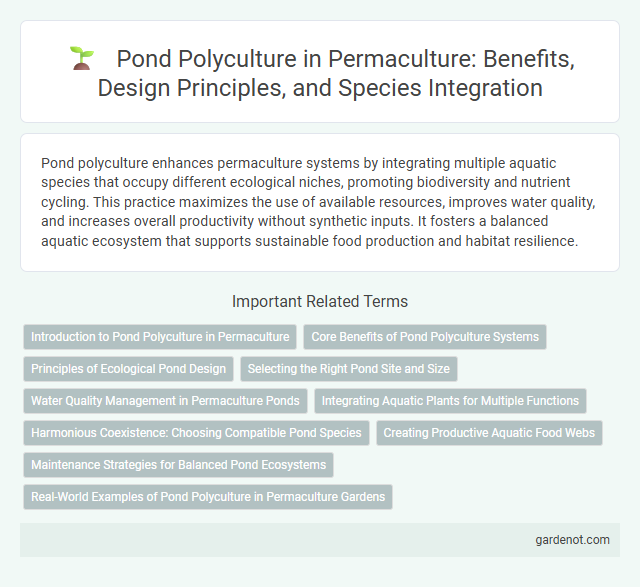Pond polyculture enhances permaculture systems by integrating multiple aquatic species that occupy different ecological niches, promoting biodiversity and nutrient cycling. This practice maximizes the use of available resources, improves water quality, and increases overall productivity without synthetic inputs. It fosters a balanced aquatic ecosystem that supports sustainable food production and habitat resilience.
Introduction to Pond Polyculture in Permaculture
Pond polyculture in permaculture involves integrating multiple compatible aquatic species within a single water body to enhance biodiversity and improve ecosystem productivity. This sustainable practice promotes natural pest control, nutrient cycling, and habitat diversity by combining fish, aquatic plants, and microorganisms in a balanced system. Implementing pond polyculture supports ecological resilience and efficient resource use, aligning with permaculture principles of sustainable land and water management.
Core Benefits of Pond Polyculture Systems
Pond polyculture enhances ecosystem resilience by promoting biodiversity through the simultaneous cultivation of multiple aquatic species such as fish, crustaceans, and aquatic plants. This integrated approach improves water quality naturally by establishing a balanced nutrient cycle, reducing the need for chemical inputs. Increased productivity and economic benefits arise from diversified yields and efficient resource utilization within a sustainable permaculture framework.
Principles of Ecological Pond Design
Ecological pond design in permaculture emphasizes biodiversity by integrating multiple aquatic species that fulfill complementary ecological roles, enhancing nutrient cycling and water quality. Designing pond polyculture systems involves selecting native fish, amphibians, and plants that create symbiotic relationships, promoting resilience against pests and diseases. Incorporating natural water filtration through emergent and submerged vegetation sustains balanced oxygen levels and supports habitat complexity for a stable aquatic ecosystem.
Selecting the Right Pond Site and Size
Selecting the right pond site for polyculture involves evaluating soil type, water availability, and sunlight exposure to ensure optimal growth conditions for multiple aquatic species. Ideal pond sizes vary depending on target species diversity, typically ranging from 0.1 to 0.5 hectares to balance ecological stability and management efficiency. Proper site selection and sizing enhance water quality, reduce predator risks, and support sustainable biomass production in permaculture systems.
Water Quality Management in Permaculture Ponds
Pond polyculture in permaculture enhances water quality by promoting biodiversity that naturally balances nutrient cycles and controls algae growth. Integrating species like ducks and fish helps reduce pests and organic waste, maintaining clear and oxygen-rich water. Effective water quality management relies on diverse plant species that filter contaminants, stabilize pond banks, and provide habitat for beneficial microorganisms.
Integrating Aquatic Plants for Multiple Functions
Integrating aquatic plants in pond polyculture enhances water quality by absorbing excess nutrients and providing natural filtration, reducing the need for chemical treatments. These plants create essential habitats for fish and beneficial microorganisms, promoting biodiversity and balanced ecosystems within the pond environment. Additionally, aquatic vegetation contributes to oxygenation and erosion control, supporting sustainable aquaculture productivity.
Harmonious Coexistence: Choosing Compatible Pond Species
Selecting compatible pond species in permaculture polyculture ensures a balanced ecosystem where fish, amphibians, and aquatic plants coexist without competition or predation imbalance. Species such as tilapia, catfish, and native aquatic plants like water lilies promote nutrient cycling, pest control, and oxygenation, enhancing overall pond health. Careful consideration of species' feeding habits, reproduction rates, and habitat preferences supports sustainable productivity and biodiversity in the pond environment.
Creating Productive Aquatic Food Webs
Pond polyculture enhances productivity by integrating multiple compatible aquatic species, optimizing nutrient cycling and reducing pest outbreaks within permaculture systems. Incorporating fish, aquatic plants, and beneficial microorganisms fosters a balanced food web that increases biomass output and improves water quality naturally. Designing these diverse ponds promotes sustainable food production while supporting ecosystem resilience and biodiversity.
Maintenance Strategies for Balanced Pond Ecosystems
Effective maintenance strategies for balanced pond ecosystems in pond polyculture include regular monitoring of water quality parameters such as pH, dissolved oxygen, and nutrient levels to prevent eutrophication. Incorporating diverse species with complementary ecological roles helps control algae growth, pest populations, and organic waste accumulation, promoting natural equilibrium. Periodic removal of excess biomass, management of aquatic plants, and ensuring appropriate stocking densities are essential for sustaining optimal habitat conditions and supporting biodiversity.
Real-World Examples of Pond Polyculture in Permaculture Gardens
Pond polyculture in permaculture gardens exemplifies sustainable aquaculture by integrating multiple species such as fish, amphibians, and aquatic plants that create balanced ecosystems. Real-world examples include Vietnam's rice-fish farming systems where carp and tilapia coexist with rice paddy crops, enhancing nutrient recycling and pest control. Similarly, permaculture farms in Australia use polyculture ponds combining native fish species with aquatic vegetables to optimize water use and biodiversity.
Pond polyculture Infographic

 gardenot.com
gardenot.com